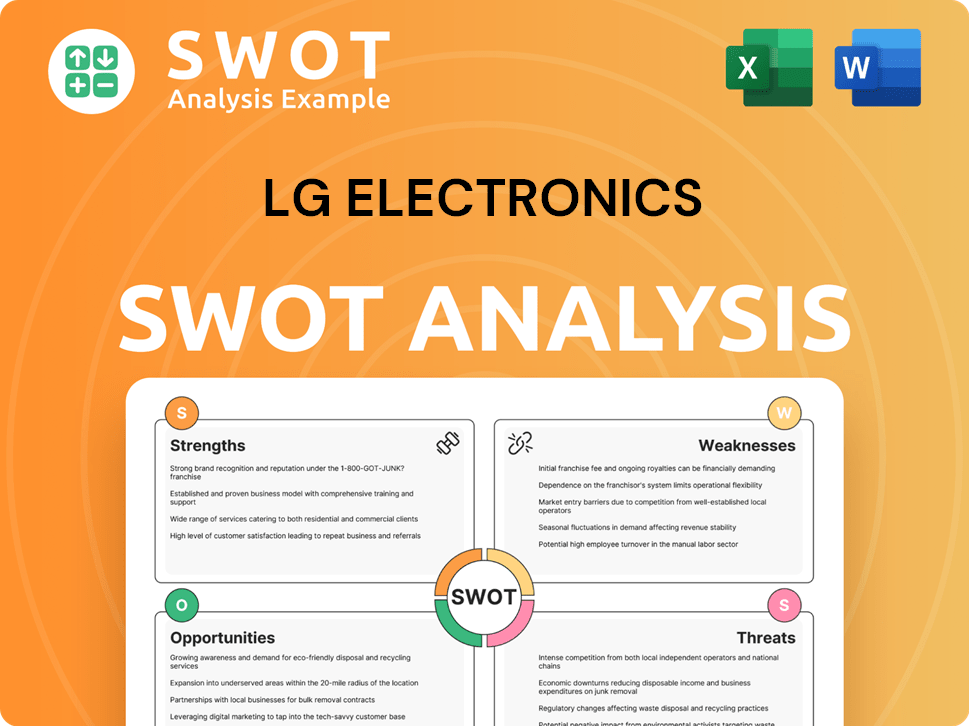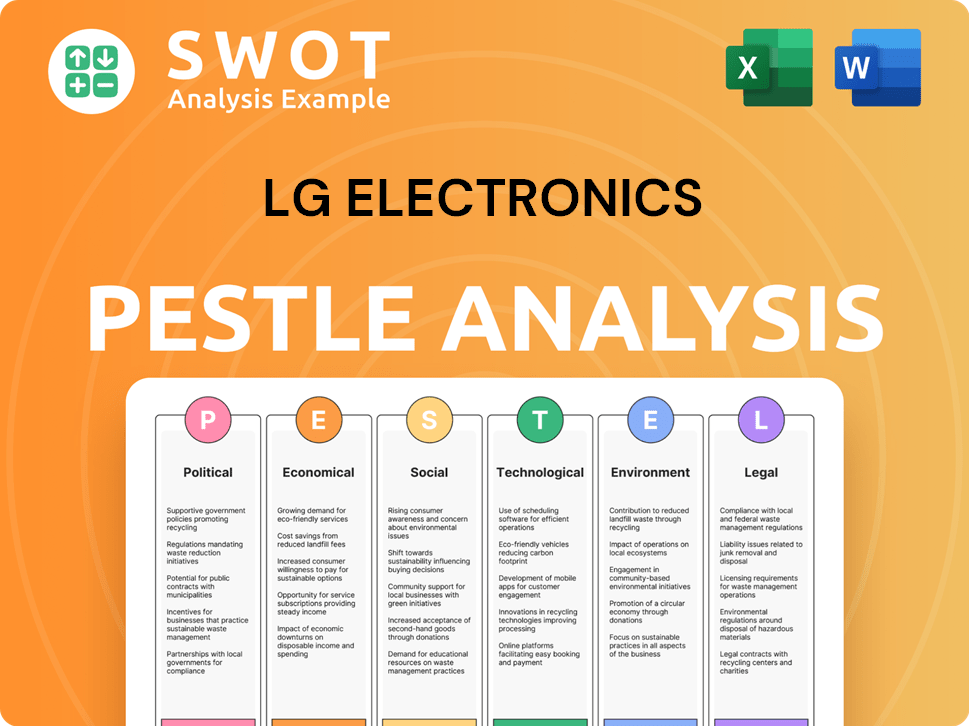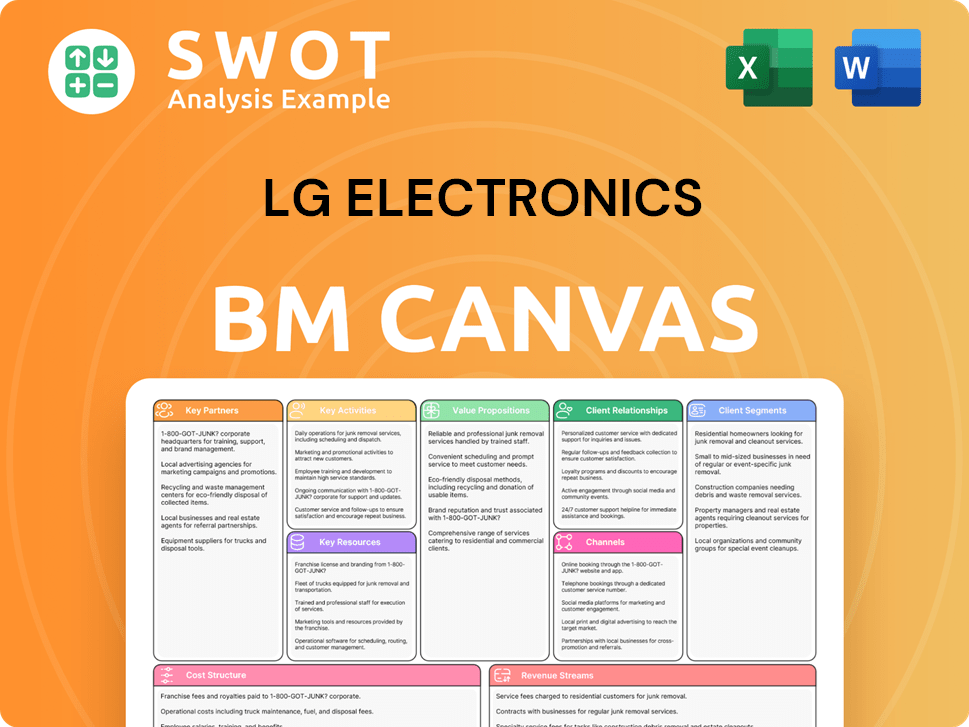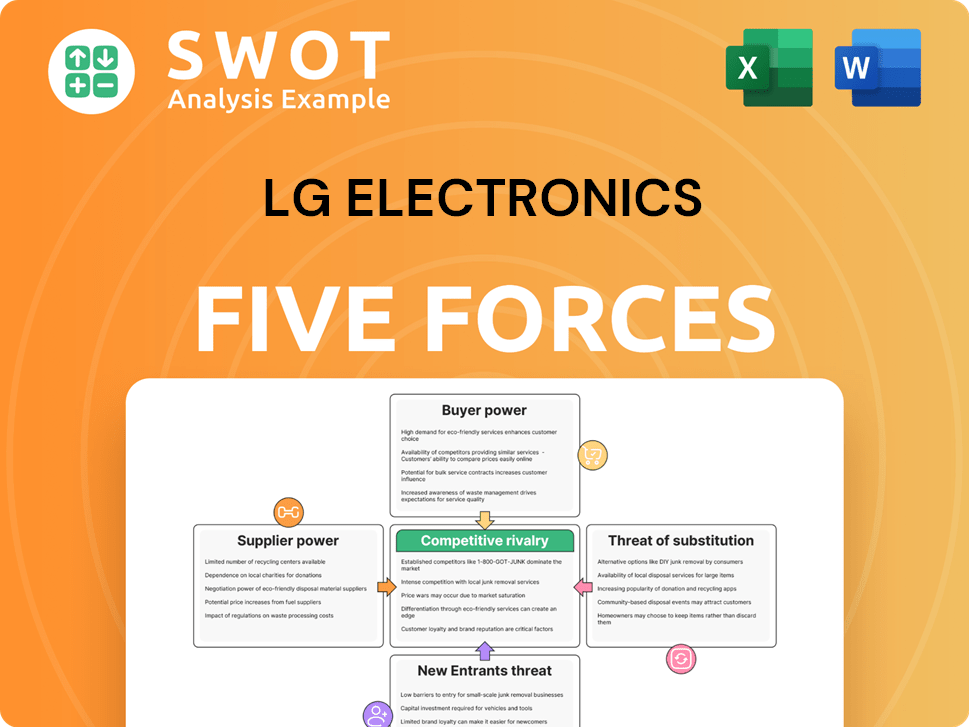LG Electronics Bundle
Can LG Electronics Maintain Its Edge in a Cutthroat Market?
LG Electronics, a titan in the consumer electronics arena, has consistently redefined the technological frontier since its inception. From its humble beginnings in South Korea, LG has evolved into a global force, influencing how we experience technology in our daily lives. This exploration dives deep into the LG Electronics SWOT Analysis, examining its strategic positioning and competitive dynamics.

Understanding the competitive landscape is crucial for investors and strategists alike, and this analysis provides a detailed market analysis LG. We'll dissect LG competitors, evaluating their impact on LG Electronics's market share analysis and exploring LG's competitive advantages and disadvantages. Furthermore, we'll investigate LG's strategies for market competition and how it differentiates itself from rivals in the dynamic electronics market.
Where Does LG Electronics’ Stand in the Current Market?
LG Electronics (LG) holds a prominent position within the global consumer electronics market, marked by a diverse product portfolio and a strong focus on innovation. The company's core operations encompass the design, manufacturing, and sale of a wide array of products, including televisions, home appliances, air solutions, and business solutions. LG's value proposition centers on delivering high-quality, technologically advanced products that enhance consumers' lifestyles, while also providing efficient and reliable solutions for businesses.
In the first quarter of 2024, LG demonstrated robust financial performance, with consolidated revenue reaching KRW 21.09 trillion (approximately USD 15.40 billion). The company's strategic emphasis on premium segments, such as OLED televisions and high-end home appliances, has contributed to its strong market position and profitability. This focus allows LG to differentiate itself from competitors and maintain a competitive edge in a dynamic market.
LG's success is further supported by its global presence and strong brand recognition. The company has cultivated a loyal customer base through consistent product quality, innovative features, and effective marketing strategies. The company's commitment to research and development ensures that it remains at the forefront of technological advancements, enabling it to introduce cutting-edge products that meet evolving consumer demands.
In Q1 2024, LG's Home Appliance & Air Solution (H&A) Company achieved sales of KRW 8.60 trillion (approximately USD 6.27 billion), a 5.2% increase year-over-year. The Home Entertainment (HE) Company recorded sales of KRW 3.49 trillion (approximately USD 2.55 billion). These figures underscore LG's strong market presence and effective strategies.
LG's primary product lines include televisions (OLED, QNED, LED), home appliances (refrigerators, washing machines, dryers, dishwashers, cooking appliances), and air solutions (air conditioners, air purifiers). The company also offers business solutions, including commercial displays and IT products. This diverse portfolio caters to a wide range of consumer and business needs.
LG has a strong global presence, with significant strength in North America and Europe for home appliances. It holds a leading position in the premium television market. LG's strategic focus on premium segments, particularly OLED televisions, supports its market share and profitability.
The H&A Company recorded an operating profit of KRW 946.1 billion (approximately USD 690.4 million), reflecting a 3.3% operating profit margin. The HE Company reported an operating profit of KRW 132.2 billion (approximately USD 96.5 million). These figures demonstrate LG's ability to maintain profitability.
LG's competitive advantages include its strong brand reputation, innovative product offerings, and global distribution network. The company's focus on premium products, particularly OLED televisions, allows it to command higher margins and maintain a competitive edge. LG's commitment to technological advancements and customer satisfaction further strengthens its market position.
- Strong brand recognition and consumer trust.
- Innovative product designs and technological advancements.
- Global presence and extensive distribution network.
- Focus on premium segments, such as OLED TVs.
LG Electronics SWOT Analysis
- Complete SWOT Breakdown
- Fully Customizable
- Editable in Excel & Word
- Professional Formatting
- Investor-Ready Format

Who Are the Main Competitors Challenging LG Electronics?
The competitive landscape for LG Electronics is dynamic, with the company facing intense rivalry across its diverse product segments. A thorough market analysis of LG Electronics reveals a complex interplay of global and regional competitors, each vying for market share and consumer attention. Understanding these key players is crucial for assessing LG's position and strategic challenges.
LG's success hinges on its ability to innovate, adapt, and differentiate itself in a crowded marketplace. The company's strategies must account for evolving consumer preferences, technological advancements, and the competitive pressures exerted by its rivals. This overview provides insight into the major competitors and the competitive dynamics that shape LG's business.
In the home appliance sector, LG's primary competitors include Samsung Electronics, Whirlpool, Bosch, and Haier. Samsung, a major South Korean conglomerate, presents a formidable challenge with its comprehensive range of appliances. Whirlpool, an American multinational, holds a strong position in North America, while Bosch, a German company, is known for its high-quality products, especially in Europe. Haier, a Chinese multinational, has expanded its global presence through competitive pricing and a diverse product portfolio.
Samsung is a leading competitor, offering a wide range of home appliances that directly compete with LG. Samsung's strength lies in its brand recognition, innovative features, and extensive distribution network. In 2024, Samsung's revenue from its consumer electronics segment was approximately $50 billion, reflecting its strong market position.
Whirlpool has a significant presence in the North American market, focusing on traditional appliance segments. Whirlpool's competitive advantage includes its established brand and strong distribution channels. Whirlpool's global revenue in 2024 was around $19 billion, demonstrating its continued relevance in the appliance market.
Bosch is known for its high-quality and energy-efficient appliances, particularly in Europe. Bosch's reputation for reliability and innovation attracts a premium customer base. In 2024, Bosch's appliance division generated approximately $16 billion in revenue, highlighting its strong performance.
Haier has gained significant market share globally through competitive pricing and a diverse product portfolio. Haier's strategy focuses on affordability and a wide range of products to appeal to various consumer segments. Haier's global revenue in 2024 reached approximately $35 billion, showcasing its rapid growth.
The home appliance market is highly competitive, with companies constantly innovating and introducing new features. Price wars, design innovations, and energy efficiency are key battlegrounds. LG must differentiate itself through superior technology, design, and customer service. The market is expected to grow, with an estimated value of $700 billion by 2025.
In 2024, Samsung held the largest market share in the global home appliance market, followed by LG, Whirlpool, and Haier. LG's market share was approximately 15%, indicating its strong position. The competition is intense, with each company striving to increase its share through product innovation and strategic partnerships.
In the television market, LG's primary competitors are Samsung, Sony, TCL, and Hisense. Samsung is a dominant force, especially in QLED technology, often competing directly with LG's OLED televisions. Sony is known for premium televisions with advanced picture processing, while TCL and Hisense have rapidly expanded their market share with competitively priced TVs. The competition often revolves around display technology, smart TV platforms, and design aesthetics.
The television market is highly competitive, with intense rivalry among the major players. LG's OLED technology faces strong competition from Samsung's QLED and other display technologies. The market is driven by technological advancements, design aesthetics, and smart TV features.
- Samsung: Samsung is a dominant player, particularly in QLED technology. In 2024, Samsung held the largest market share in the global TV market, with approximately 30%.
- Sony: Sony is known for its premium televisions with advanced picture processing. Sony's focus on high-end products and innovative features allows it to maintain a strong position. Sony's TV revenue in 2024 was approximately $10 billion.
- TCL: TCL has rapidly expanded its market share by offering competitively priced televisions with advanced features. TCL's strategy focuses on value and affordability. TCL's global TV shipments in 2024 reached over 25 million units.
- Hisense: Hisense has also gained significant market share through competitive pricing and a focus on advanced features. Hisense's growth has been particularly strong in international markets. Hisense's TV revenue in 2024 was approximately $12 billion.
The business solutions segment faces competition from companies like Samsung, Sony, and various specialized IT and display manufacturers. This segment requires a focus on specialized products and services tailored to business needs. The competitive landscape in this area is driven by the demand for innovative display solutions and IT infrastructure.
LG Electronics PESTLE Analysis
- Covers All 6 PESTLE Categories
- No Research Needed – Save Hours of Work
- Built by Experts, Trusted by Consultants
- Instant Download, Ready to Use
- 100% Editable, Fully Customizable

What Gives LG Electronics a Competitive Edge Over Its Rivals?
LG Electronics (LG) stands out in the competitive landscape through several key advantages. These advantages are crucial for understanding its market position and strategies. The company's focus on innovation and consumer needs has helped it maintain a strong competitive edge. These factors play a significant role in its ability to compete effectively in the electronics market.
The company's success is also driven by its strategic decisions and investments in technology. LG has consistently invested in research and development, leading to advancements in display technology and home appliances. Its global presence and efficient supply chain also contribute to its competitive strength. These elements are essential for LG to maintain its market position and adapt to changing consumer demands.
LG's ability to innovate and adapt to market changes is crucial for its long-term success. The company's focus on premium products and sustainable practices also strengthens its brand image. These strategies help LG differentiate itself from competitors and maintain its market share. For more details on its business model, you can read Revenue Streams & Business Model of LG Electronics.
LG's leadership in OLED display technology is a significant competitive advantage. LG Display, a subsidiary, is a major producer of OLED panels, providing LG with a unique edge in the premium TV market. This technology offers superior picture quality, contrast, and viewing angles, setting LG apart from many competitors in the electronics market.
LG's strong brand equity, built over decades, fosters customer loyalty and trust. This is particularly evident in the home appliance sector, where LG products are associated with reliability and innovation. This brand recognition helps LG maintain a competitive advantage in a crowded market.
LG benefits from economies of scale through its global manufacturing and distribution networks. This allows for cost efficiencies in production and logistics, making its products more competitive. A well-established supply chain is critical for success in the electronics market.
LG's focus on design and aesthetics differentiates its products, especially in premium home appliances and televisions. This appeals to consumers seeking both functionality and visual appeal. The company's design-centric approach helps it stand out in the competitive landscape.
LG's competitive advantages include technological leadership, brand equity, and efficient operations. These strengths are essential for maintaining its market position. LG's ability to innovate and adapt is crucial in the fast-paced electronics market.
- OLED Technology: Leading in OLED display technology provides a significant advantage in the premium TV market.
- Brand Reputation: Strong brand recognition fosters customer loyalty and trust, particularly in home appliances.
- Global Operations: Efficient manufacturing and distribution networks enable cost efficiencies.
- Design Focus: Emphasis on design and aesthetics differentiates products and attracts consumers.
LG Electronics Business Model Canvas
- Complete 9-Block Business Model Canvas
- Effortlessly Communicate Your Business Strategy
- Investor-Ready BMC Format
- 100% Editable and Customizable
- Clear and Structured Layout

What Industry Trends Are Reshaping LG Electronics’s Competitive Landscape?
The competitive landscape for LG Electronics is dynamic, shaped by technological advancements, regulatory changes, and global economic shifts. LG must continuously innovate and adapt to maintain its market position. Understanding the current industry trends, future challenges, and available opportunities is critical for LG's strategic planning and sustained success in the electronics market.
The company faces intense competition from both established rivals and emerging players. Continuous market analysis is essential to navigate these complexities. LG needs to leverage its strengths and address its weaknesses to thrive in a rapidly evolving electronics market.
Technological advancements, particularly in AI, IoT, and smart home integration, are crucial. Consumers want interconnected devices and intelligent features. Regulatory changes regarding energy efficiency and environmental impact also drive product innovation.
Intense price competition from Chinese manufacturers and the rapid pace of technological obsolescence are key challenges. Supply chain disruptions and global economic shifts, including inflation, also pose significant hurdles. Maintaining market share requires continuous innovation and strategic adaptation.
The smart home market's growth and demand for premium, energy-efficient appliances offer significant opportunities. Expansion into emerging markets can drive growth. Leveraging AI and IoT capabilities can create a more integrated ecosystem.
Focusing on premiumization and expanding B2B solutions are key. Developing AI and IoT capabilities is essential. Understanding the competitive landscape and adapting to consumer preferences is crucial for long-term success.
The electronics market is highly competitive, with LG facing strong rivals. LG's strategies involve premiumization, B2B expansion, and leveraging AI and IoT. The company's success depends on its ability to innovate and adapt to market changes.
- Market Analysis: Continuous assessment of consumer preferences and competitor actions is vital.
- Product Innovation: Developing advanced and energy-efficient products is key to staying ahead.
- Strategic Partnerships: Collaborations can enhance market reach and technological capabilities.
- Global Expansion: Targeting emerging markets offers growth potential, but requires adaptation.
LG Electronics Porter's Five Forces Analysis
- Covers All 5 Competitive Forces in Detail
- Structured for Consultants, Students, and Founders
- 100% Editable in Microsoft Word & Excel
- Instant Digital Download – Use Immediately
- Compatible with Mac & PC – Fully Unlocked

Related Blogs
- What are Mission Vision & Core Values of LG Electronics Company?
- What is Growth Strategy and Future Prospects of LG Electronics Company?
- How Does LG Electronics Company Work?
- What is Sales and Marketing Strategy of LG Electronics Company?
- What is Brief History of LG Electronics Company?
- Who Owns LG Electronics Company?
- What is Customer Demographics and Target Market of LG Electronics Company?
Disclaimer
All information, articles, and product details provided on this website are for general informational and educational purposes only. We do not claim any ownership over, nor do we intend to infringe upon, any trademarks, copyrights, logos, brand names, or other intellectual property mentioned or depicted on this site. Such intellectual property remains the property of its respective owners, and any references here are made solely for identification or informational purposes, without implying any affiliation, endorsement, or partnership.
We make no representations or warranties, express or implied, regarding the accuracy, completeness, or suitability of any content or products presented. Nothing on this website should be construed as legal, tax, investment, financial, medical, or other professional advice. In addition, no part of this site—including articles or product references—constitutes a solicitation, recommendation, endorsement, advertisement, or offer to buy or sell any securities, franchises, or other financial instruments, particularly in jurisdictions where such activity would be unlawful.
All content is of a general nature and may not address the specific circumstances of any individual or entity. It is not a substitute for professional advice or services. Any actions you take based on the information provided here are strictly at your own risk. You accept full responsibility for any decisions or outcomes arising from your use of this website and agree to release us from any liability in connection with your use of, or reliance upon, the content or products found herein.